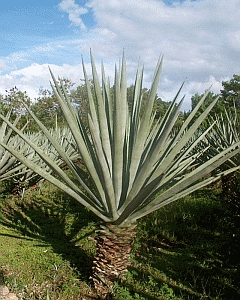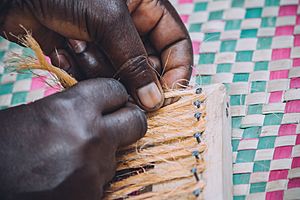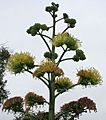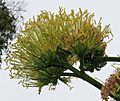Sisal facts for kids
Quick facts for kids SisalAgave sisalana |
|
|---|---|
 |
|
| Scientific classification | |
| Genus: |
Agave
|
| Species: |
sisalana
|
Sisal (Agave sisalana) is a type of flowering plant that originally came from southern Mexico. Now, you can find it growing in many other countries around the world. This plant is super useful because it gives us a strong fibre that people use to make ropes and many other products.
Sisal fibre is traditionally used for rope and twine. But it's also used to make things like paper, cloth, footwear, hats, bags, carpets, and even dartboards! It can also make other materials stronger, like fibreglass and concrete. And guess what? You can even ferment and distill it to make a drink called mezcal.
Sisal plants usually live for 7 to 10 years. During their life, they produce about 200 to 250 leaves that are full of these useful fibres. Sisal loves warm, sunny places, especially where temperatures are above 25°C.
Long ago, the Aztecs and Mayans used sisal to make fabric and paper. In the 1800s, sisal growing spread to other parts of the world. Today, Brazil is the biggest producer of sisal. While sisal farming used to cause some environmental problems, it's now seen as less harmful than many other types of farming.
In 2020, the world produced about 210,000 tonnes of sisal. Brazil was the top producer, followed by countries like Tanzania, Kenya, Madagascar, China, and Mexico.
Contents
Where Sisal Comes From
Scientists aren't completely sure where the Agave sisalana plant first grew naturally. People used to think it came from the Yucatán Peninsula in Mexico. It got its name because the first plants were shipped from a port there called Sisal. However, the farms in Yucatán now mostly grow a different plant called henequen (Agave fourcroydes).
Some experts believe sisal might have first grown in Chiapas, another part of Mexico. This idea comes from how people there traditionally used the plant in small home businesses. It might even be a mix of two other agave plants. Now, sisal grows naturally in many other places, including Spain, parts of Africa, China, India, Hawaii, and Florida.
What the Plant Looks Like
Sisal plants have a bunch of sword-shaped leaves that grow in a circle, like a rosette. These leaves can be about 1.5 to 2 meters (5 to 6.5 feet) tall. When the leaves are young, they might have tiny teeth along their edges, but these disappear as the leaves get older.
A sisal plant lives for about 7 to 10 years. During this time, it produces 200 to 250 leaves that can be used to get fibre. Each leaf has around 1000 fibres! However, the fibres only make up about 4% of the plant's total weight. Sisal grows best in warm, sunny places, like tropical and subtropical regions.
How Sisal is Grown
Long ago, the Aztecs and the Mayans used sisal to make fabrics and paper.
In the 1800s, sisal farming started to spread. It went to places like Florida, the Caribbean islands, and Brazil. It also spread to countries in Africa, especially Tanzania and Kenya, and to parts of Asia. It's said that sisal came to Africa from Florida, thanks to a German botanist named Hindorf.
In Cuba, sisal farming began in 1880. Brazil started its first commercial sisal farms in the late 1930s. The first sisal fibre was shipped from Brazil in 1948. Brazil's production really grew in the 1960s, and it's now the biggest sisal producer in the world.
How Sisal Plants are Grown (Propagation)
Sisal plants are usually grown from small plantlets called bulbils. These grow from buds on the flower stalk. Or, they can be grown from suckers, which are small shoots that grow around the bottom of the main plant. These small plants are first grown in special nursery fields. Once they are big enough, they are moved to their permanent spots in the fields.
How Fibre is Taken Out (Extraction)
To get the fibre, the leaves go through a process called decortication. This is where the leaves are crushed and beaten by a spinning wheel with blunt knives. This removes all the plant material, leaving only the fibres. In some places, like East Africa, water is used to wash away the waste parts of the leaves.
After the fibre is taken out, it needs to be dried. Drying it properly is very important for the quality of the fibre. Sometimes, machines are used to dry it, which often results in better quality fibre than drying it in the sun. Once dry, the fibres are brushed and then pressed into large bales for shipping. In drier areas, like northeast Brazil, small farmers often use portable machines that don't need water to extract the fibre.
The dry fibres are then combed by machines and sorted into different grades. This sorting is often based on the size of the leaves they came from.
-
A sisal farm in Morogoro, Tanzania, with mountains in the background
Sisal and the Environment
When sisal farming first started, it sometimes harmed the environment. This was because sisal farms replaced native forests. However, sisal farming is now seen as less damaging than many other types of farming. Farmers don't use chemical fertilizers for sisal. While they sometimes use weed killers, most weeding is done by hand, which is better for the environment. One problem can be the wastewater from the fibre extraction process if it flows into rivers.
Sisal is considered an invasive species in places like Hawaii and Florida. This means it can grow too much and take over areas where native plants should be.
What Sisal is Used For
For a long time, sisal was the main material for farm twine. This is because it's strong, lasts a long time, can stretch, and doesn't get ruined by saltwater. However, other materials like polypropylene are now used more for twine. So, new and more valuable products are being made from sisal.
Besides ropes and twines, sisal is used for many other things. These include paper, dartboards, polishing cloths, filters, mattresses, and carpets. It's also used in crafts and to make cores for wire ropes. Sisal is also a good, eco-friendly material to make things stronger, replacing materials like asbestos in cars.
Lower quality sisal fibre is used to make paper. Medium quality fibre is used for ropes and twine for farming and industry. The best quality fibre is made into yarns and used to make carpets.
Other products made from sisal include spa items, cat-scratching posts, back support belts, rugs, slippers, and disc buffers. Sisal wall coverings are strong and meet safety standards for homes.

Since only a small part of the plant is used for fibre, people are trying to use the leftover parts. They are exploring using the waste to make biogas (a type of fuel), animal feed, or even to get medicines from it.
Sisal plants are also great for honeybees because they flower for a long time. Bees especially love them when other flowers are scarce. However, the honey made from sisal flowers is dark and has a strong taste.
Because sisal is an agave plant, it can be fermented and distilled to make mezcal, a type of alcoholic drink. In India, it might even be used in some street food snacks.
Sisal Carpets
Sisal carpets are known for being strong. However, in areas with a lot of foot traffic, they might flatten a little. Sisal carpets don't build up static electricity, and they don't trap dust. So, all you need to do to clean them is vacuum. If you spill something, it's best to use a special fibre sealer and a dry-cleaning powder. Sisal can absorb moisture from the air or release it, which might make it expand or shrink. Because of this, sisal carpets are not recommended for places that get wet, like near doors where rain or snow might come in. Sisal is used alone in carpets or mixed with wool for a softer feel.
Sisal Around the World
| 86.1 | |
| 36.4 | |
| 22.8 | |
| 17.6 | |
| 14.0 | |
| 13.1 | |
| 12.0 | |
| World total | 209.9 |
In 2020, the world produced about 210,000 tonnes of sisal fibre. Brazil was the biggest producer, making 86,061 tonnes.
Tanzania produced about 36,379 tonnes, Kenya produced 22,768 tonnes, and Madagascar produced 17,578 tonnes. China made 14,006 tonnes, and Mexico contributed 13,107 tonnes. Smaller amounts came from Haiti, Morocco, Venezuela, and South Africa. Sisal is one of the top plant fibres in the world.
Sisal in Symbols
The sisal plant can be seen on the coat of arms of Barquisimeto, a city in Venezuela.
There's also an unofficial coat of arms for the Yucatán State in Mexico that shows a deer jumping over a sisal plant.
See also
 In Spanish: Agave sisalana para niños
In Spanish: Agave sisalana para niños
- Fiber rope
- Henequen
- Sisal production in Tanzania







